Interconnected smoke detector purchasing advice: how to choose the right product
- The most important facts in brief
- The installation of several radio smoke detectors ensures a prompt smoke warning even in large flats and houses.
- If one of the devices detects smoke in a room, all the warning detectors sound.
- Wireless smoke detectors with the quality mark Q meet high safety requirements.
- If the radio smoke detectors can be muted at the touch of a button, they are even suitable for the kitchen.
- Depending on the ceiling, they can be mounted with screws or adhesive pads.
Prepared for emergencies
Many people die in house and flat fires. The cause of death is often not even the fire itself, but smoke poisoning due to the smoke produced. It only takes a moment of carelessness and a burnt candle can start a fire. Moreover, it takes too long at night for sleeping residents to notice anything – unless they have a warning system that alerts them in case of fire.
To protect your own life and that of your loved ones, good smoke detectors are essential. In an emergency, they detect the rising smoke and alert all members of the household. In the meantime, smoke detectors are also legally obligatory in old and new residential buildings. Owners and landlords are responsible for purchasing them and having them checked annually.
How do smoke detectors work?
The most common smoke detectors for private use are optical models. Other names for the detection technology are photoelectronic or photo-optical. Optical smoke detectors work according to the so-called scattered light method. The smoke chamber usually contains an infrared light-emitting diode and a light-sensitive sensor. Provided there is no interference, the light-emitting diode emits a beam of light in such a way that it does not hit the sensor. If smoke forms in larger quantities, the particles also penetrate the optical chamber and scatter the light beam. The light hits the sensor and the smoke detector’s warning tone sounds.
What characterises radio smoke detectors
In large flats and houses, it sometimes makes sense to network smoke detectors together. This has the advantage that residents are alerted to fires even if they are far from the affected room. Even in smaller flats, linked smoke detectors can be practical, provided they are located in a high-noise environment such as a main road.
A simple way to link smoke detectors together is by radio signals. This does not require a central control unit. The smoke detectors connect to each other by periodically emitting radio signals. In case of an alarm, all networked devices sound simultaneously.
What matters when buying
With smoke detectors of any kind, the most important thing is whether they have been certified as effective and efficient by independent test centres. Only when safety is guaranteed do criteria such as the type of battery become relevant.
Certified safety
In order for radio smoke detectors to be sold in the European Union, manufacturers must CE mark them and confirm that the products comply with EU standards. This requires a conformity assessment and the issuing of an EU declaration of conformity.
The European product standard in question is DIN EN 14606, which specifies the requirements in terms of technical equipment and functionality that smoke detectors must at least meet. The test can, but does not have to, be carried out by an independent test centre. Ideally, a TÜV was involved in the testing of the wireless smoke detectors. A TÜV certification is usually stated in the product description or visible on the packaging.
The Q quality label
The Q-label identifies high-quality smoke detectors that are not only durable but also better protected against false alarms. It is based on a guideline of the Association for the Promotion of German Fire Protection (vfdb) for the identification of high-quality and safe smoke detectors. The vfdb guideline 14-01 supplements the minimum requirements of DIN EN 14604 with even stricter quality and test criteria. These include, for example, high stability of the housing, high resistance to humid room climates, corrosion, temperature changes and improved electronics.
Unlike the award of the CE mark, certification must be carried out by an accredited testing institute. This task is usually performed by VdS Schadensverhütung GmbH in Cologne or KRIWAN Testzentrum GmbH in Forchtenberg.
From 2024, the trademark statutes of the European warranty mark Q, which was registered with the European Union Intellectual Property Office (EUIPO) at the end of 2020, will apply. The Q mark will only be awarded if testing and certification have taken place in accordance with the trademark statutes.
Networking and range
Other aspects are the range of the radio signal and the number of smoke detectors that can be networked together. The average range of radio smoke detectors is 100 metres outdoors. Even inexpensive models have a range of 40 metres. However, the ranges are always measured under ideal conditions. In practice, they are reduced by obstacles in the form of furniture and brickwork. For multi-storey houses or long flats, 40 metres is sometimes too little to network all wireless smoke detectors together without interference.
The number of wireless smoke detectors that can be networked varies greatly depending on the product series. While some systems allow the networking of a maximum of 12 detectors, others allow extensive networks of more than 30 wireless detectors.
Optional or permanently installed radio module
There are two types of radio smoke detectors: those with an integrated radio module and those to which a radio module can be attached. Products with an optional radio module can also be used as individual smoke detectors. If necessary, they can easily be converted into radio smoke detectors, for example when moving into a larger flat or to protect newborn babies. The radio module is usually attached to the underside of the detector. A separate battery ensures that it does not affect the runtime of the smoke detector. However, smoke detectors with an optional radio module are more expensive than those with a permanently installed one.
Power supply
The power supply for radio smoke detectors is either provided by simple exchangeable batteries or long-life batteries. The replaceable batteries are non-rechargeable AA batteries that must be replaced regularly. Although radio smoke detectors with this type of battery are cheaper than those with long-life batteries, they also incur follow-up costs.
Radio smoke detectors with permanently installed lithium-ion batteries have a service life of around ten years. Since it is not possible to change the batteries, such smoke detectors must be disposed of as soon as the battery is empty. The countdown starts when the smoke detector is activated. Some products have a specific expiry date for the battery. However, how long the battery lasts also depends on the external conditions: Lithium-ion cells are sensitive to cold and discharge faster at low temperatures.
In the meantime, there are also radio smoke detectors with replaceable lithium-ion batteries that can be used for five or ten years, depending on the product. If the battery is discharged before the official expiry date of the smoke detector, it can simply be replaced. However, it is not advisable to operate the smoke detector beyond its expiry date, as its proper functioning is then no longer guaranteed.
Practical functions
Some modern radio smoke detectors have interesting additional functions. For example, it is very helpful not only for hearing-impaired or deaf people if the smoke detector that triggers the alarm is distinguished from the others by a red light-emitting diode. Some manufacturers even offer their own systems for people with impaired hearing. Ei Electronics, for example, has a control unit in its range that couples warning devices with a stroboscopic light and a vibration pad.
In the case of radio smoke detectors with replaceable batteries, it is practical if they inform when replacement is required. Furthermore, there are devices that are designed to prevent insects from entering the smoke chamber. This is not only good for the little creepy-crawlies, but also prevents false alarms that could set them off.
In the event of a false alarm, it saves nerves if you can mute the wireless smoke detector by pressing a button. For products with replaceable batteries, for example, it is otherwise necessary to take them down from the ceiling and remove the batteries. With the mute function, the detector is usually muted for about ten minutes. During this time, no acoustic signal sounds even in the event of another alarm. Radio smoke detectors with mute function are also suitable for kitchen installations: If they are accidentally triggered while cooking, this is not a disaster.
Alternatives for the kitchen
Besides smoke detectors, there are other methods to detect or prevent fires in the kitchen. Heat detectors, for example, measure the temperature in the room and sound the alarm as soon as it exceeds 60 degrees Celsius. There are also cooker alarms and cooker monitors. Both variants react when they register high cooker temperatures or dish towels and food that have caught fire. While cooker alarms only trigger a loud signal, cooker detectors also switch off the cooker.
Some wireless smoke detectors indicate that they are working properly with a small, flashing LED light. If you find the light annoying when you are falling asleep, you can choose a device that automatically turns it off at night.
There are also combined devices such as smoke and heat detectors or smoke and carbon monoxide detectors. Although neither carbon monoxide nor heat detectors are required by law, installing them provides additional safety.
Mounting
The classic way to fix smoke detectors to the ceiling is with plugs and screws. However, there are ceiling materials that cannot be easily drilled into. Adhesive pads with magnets are an alternative. One adhesive pad goes on the ceiling, the other on the mounting base of the smoke detector. The magnets ensure that the smoke detector stays in place on the ceiling. It is even easier to attach the smoke detector using double-sided adhesive tape. However, this method sometimes leads to difficulties when the smoke detector needs to be removed for maintenance or battery replacement.
The correct positioning of radio smoke detectors
The smoke detector obligation prescribes smoke detectors in private households. In some federal states, such as Berlin and Brandenburg, even the corridors and all common rooms except the kitchen require these warning devices. Depending on the spatial conditions, for example partial walls or sloping roofs, the installation location and the number of detectors may change.
According to DIN 14 676, rooms larger than 60 square metres need more than one smoke detector. In smaller rooms, the smoke detector should ideally be mounted centrally on the ceiling. A minimum distance of 50 centimetres to the ceiling and to furnishings is required. Otherwise they can obstruct the path of smoke to the detector and thus delay the alarm.
Several smoke detectors should also be installed in rooms with room dividers in the form of walls or furniture and in rooms with joists. These design elements block the rising smoke, similar to ceiling lamps. Here, too, the detection device should be located as far as possible in the centre of the subarea. If a joist or ceiling beam is more than 20 centimetres high and has an area of more than 36 square metres, a smoke detector should be placed on both sides.
While radio smoke detectors in horizontal ceilings should be placed in the middle of the room if possible, sloping ceilings are a special case. This is because the ceiling of attic rooms tapers at an acute angle. A heat cushion forms at this point, which prevents smoke from entering the smoke chamber. Therefore, a distance of 50 to 100 centimetres from the roof peak must be observed during installation. This also applies to partial roof slopes that merge into a horizontal ceiling.
Installation in the hallway
In straight corridors with a maximum width of 3.0 metres and a maximum length of 15.0 metres, one smoke detector in the centre is sufficient. The maximum distance to the end of the corridor is not more than 7.5 metres. If a corridor is longer than 15.0 metres, position smoke detectors at a distance of 7.5 metres from the end. The distance between smoke detectors cannot be more than 15.0 metres. In L- or U-shaped conditions, a smoke detector ideally comes to the mitre line, i.e. in the angled area.

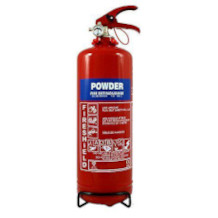
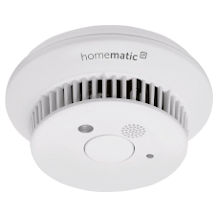
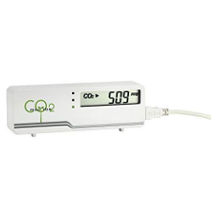
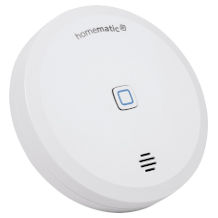
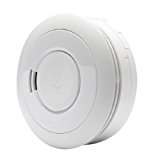
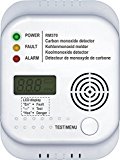
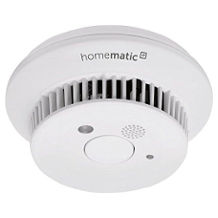


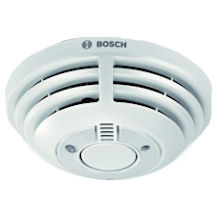
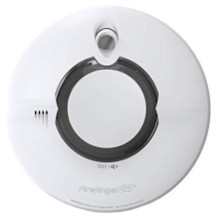
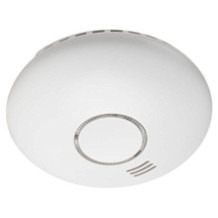
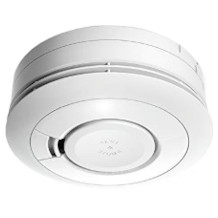
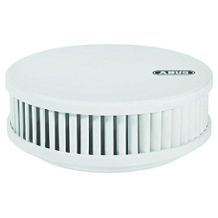

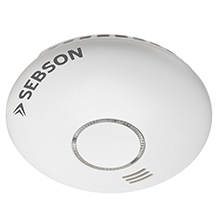
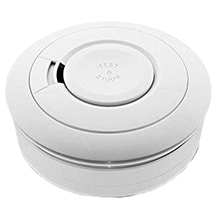

 1,370 reviews
1,370 reviews
